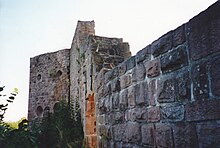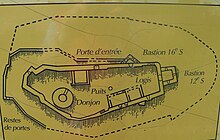Frankenburg (Alsace)
| Frankenburg | |
|---|---|
|
The ruins of the Frankenburg (view from the west) |
|
| Alternative name (s): | Frankenbourg |
| Creation time : | Early 12th century |
| Castle type : | Höhenburg, summit location |
| Conservation status: | ruin |
| Place: | Neubois |
| Geographical location | 48 ° 17 ′ 43 " N , 7 ° 19 ′ 30" E |
| Height: | 703 m |
The Frankenburg ( French Château du Frankenbourg ) is the ruin of a hilltop castle from the beginning of the 12th century near Sélestat in the area of Neubois in Alsace . The castle ruins are listed as a monument historique .
location
The Frankenburg lies at a height of 703 m on the summit of the Schlossberg , which is dominated by the Altenberg massif to the west . In a strategically favorable position, the castle oversees the confluence of the Giessen and Lièpvrette , whose valleys open up the central Vosges . On the mountain are the ruins of the castle, which is surrounded by three walls, the time of which has not yet been conclusively clarified, but which probably go back to the Latène period.
history
prehistory
The upper or innermost of the three walls ( mur supérieur or mur franc ) adjoins the medieval castle immediately to the west. Its time is unclear, it probably belongs to a predecessor of the castle. The middle wall ( mur païen = pagan wall ) encloses an area of 1.7 hectares and was built over in its eastern part by the medieval castle. It was built in the 4th century at the latest. The pagan wall was registered as a monument historique in 1990.
The preserved section of the lower or outer wall line ( mur inférieur ) lies directly on the pass between the Schlossberg in the east and the Altenberg in the west. If the wall enclosed the Schlossberg at a constant height, it covered an area of seven to eight hectares. During excavations in 2014, the remains of a post slot wall were found and, among other things, three Nauheim fibulae as well as Celtic and Roman coins were recovered. Since the fibulae, which are typical of the late La Tène period, were found below the base of the wall, they define a terminus post quem . The outer wall can therefore be built in the second half of the 1st century BC at the earliest. Have been erected.
middle Ages
The report by Daniel Specklin from the 16th century that the Frankenburg was built by the Merovingian Clovis I after the conquest of Alsace is probably legendary .
The castle was probably built at the beginning of the 12th century, possibly on the site of an older complex. It was first mentioned in 1143 as the property of the Counts of Frankenburg, a branch line of the Counts of Saarbrücken , who called themselves Counts of Werd from 1189 and, from shortly after 1196, the Landgraves in Lower Alsace . Henry II. Sigebert of Werd (1239-1278) was the third quarter of the 13th century keep building. Since the economic situation of the Counts von Werd quickly deteriorated in the 14th century, they pledged the castle to the von Mullenheim family around 1336. After the Counts of Werd died out, their heirs, the Counts of Oettingen , sold the remains of the inheritance, including the Frankenburg, to the bishopric of Strasbourg in 1359 .
Between 1393 and 1489, the Strasbourg bishopric pawned the castle in quick succession to various families who initially belonged to the immediate vicinity of the Counts of Werd. In 1393 Johann von Leiningen-Rixingen († 1442/45) received the castle. The brothers Claus and Adam Zorn followed him as early as 1394 or 1395. In 1411 it went to Burkhard von Lützelstein, a relative of Johann von Leiningen-Rixingen, who was followed in 1418 by his sons Jacob and Wilhelm. They sold parts of the castle in 1449 to Hans von Uttenheim zu Ramstein and Claus Bock, in 1454 to Jacob von Hohenstein and in 1462 to the Strasbourg Cathedral Chapter, the city of Schlettstadt and the Wurmser family. In 1489 the Strasbourg cathedral chapter took over all the shares and held them until 1789, when it was expropriated in the course of the French Revolution . Since then the castle has been owned by the state.
The Frankenburg was destroyed by fire in 1582, but was then rebuilt. From the beginning of the 17th century it was in poor condition and deteriorated.
The ruins were uncovered by volunteers in the 1970s and 1980s. The keep was restored in 1981.
investment
The polygonal wall of the Frankenburg follows the sandstone rock used as a foundation . The elongated castle complex is oriented roughly in a north-south direction. Their access is on the east side facing the valley. To protect the gate, a triangular flanking tower was added to the medieval wall in the 16th century. Inside the enclosure wall, in the north, there is the stump of the round donjon built in the 13th century made of bossed ashlars and on the west side remains of the residential buildings. The castle complex is closed off to the south by a bastion from the 12th century.
literature
- Thomas Biller, Bernhard Metz: The castles of Alsace - architecture and history. Volume 1: The beginnings of castle building in Alsace (until 1200) . Published by the Alemannic Institute Freiburg i. Br., Deutscher Kunstverlag, Munich / Berlin 2018, ISBN 978-3-422-07439-2 , pp. 256–269.
- Nicolas Mengus, Jean-Michel Rudrauf: Châteaux forts et fortifications médiévales d′Alsace. Dictionnaire d′histoire et d′architecture . La Nuée Bleue, Strasbourg 2013, ISBN 978-2-7165-0828-5 , pp. 96-97.
- Annuaire de la Société d'Historie du Val de Villé , Vol. 30 (2005), ISSN 0399-2330 . ( Content ; French)
Web links
- Le Frankenbourg à Neubois (67). Une fortification protohistorique, romaine et médiévale (French) - excavation reports from the 2014–2018 campaigns
Individual evidence
- ↑ Ruines du château du Frankenbourg in the Base Mérimée of the French Ministry of Culture (French)
- ↑ a b c Clement Féliu, Florent Jodry, Laurie Tremblay-Cormier: La fortification du Frankenbourg à Neubois (Bas-Rhin). [Research paper]. ( online ; French)
- ^ Enceinte protohistorique de la Frankenbourg in the Base Mérimée of the French Ministry of Culture (French)
- ↑ Frankenbourg. Alsace Destination Tourisme, accessed September 5, 2019 (French).
- ↑ a b c d Château fort de Frankenbourg in the Inventaire général du patrimoine culturel of the French Ministry of Culture (French)
- ↑ Château de Frankenbourg. Neubois. Office du tourisme du Val de Villé, accessed on September 5, 2019 (French).



